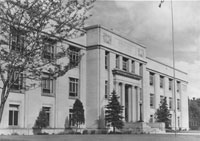Summary of Decision July 25, 2011
[SPECIAL NOTE: This opinion uses the "Universal Citation." It was given an "official" citation when it is issued. You should use this citation whenever you cite the opinion, with a P.3d parallel citation. You will also note when you look at the opinion that all of the paragraphs are numbered. When you need to provide a pinpoint citation to a quote the universal portion of the citation will use that paragraph number. The pinpoint citation in the P.3d portion will need to have the reporter page number. If you need assistance in putting together a citation from this, or any future opinion using the Universal Citation form, please contact the Wyoming State Law Library and we will provide any needed assistance]
Summaries are prepared by Law Librarians and are not official statements of the Wyoming Supreme Court
Case Name: Michael Darren Downing v. The State of Wyoming
Citation: 2011 WY 113
Docket Number: S-10-0128
Appeal from the District Court of Natrona County the Honorable W. Thomas Sullins, Judge
Representing Appellant (Petitioner): Donald L. Fuller and Ian K. Sandefer of Krampner, Fuller & Associates, L.L.C., Casper, Wyoming. Argument by Mr. Sandefer.
Representing Appellee (Respondent): Bruce A. Salzburg, Wyoming Attorney General; Terry L. Armitage, Deputy Attorney General; D. Michael Pauling, Senior Assistant Attorney General; Leda M. Pojman, Senior Assistant Attorney General. Argument by Ms. Pojman.
Date of Decision: July 25, 2011
Facts: On November 12, 2008, a confidential informant (the CI) working with the Wyoming Division of Criminal Investigation (DCI), made a recorded telephone call to the appellant to arrange the illegal purchase of morphine pills. The CI was then given $1,800 in “buy money” and driven to JC’s house, where the CI allegedly gave the buy money to the appellant in exchange for 18 morphine pills. Present at the house in addition to the appellant were JC and SM. The CI was “wired” during the transaction, but background noise diminished the quality of the recording. The buy money was not recovered because a search warrant was not immediately executed. After a jury trial, the appellant was convicted of one count of unlawful delivery of a controlled substance, morphine. He appealed that conviction, challenging several district court rulings and the competence of defense counsel, and alleging prosecutorial misconduct, as well as cumulative error.
Issues: The appellant presented ten issues for review, but the Court addressed only the single issue found to be dispositive: Whether the district court abused its discretion in prohibiting the appellant from producing evidence attacking the credibility of a confidential informant in support of the appellant’s theory of the case.
Holdings: The appellant alleged that the district court abused its discretion by denying his pretrial motion seeking discovery of “other buys” in which the CI participated, and by excluding at trial evidence of other such buys. The appellant contended that these rulings prevented the jury from hearing relevant evidence of his theory of defense that the CI was “conning” DCI, prevented the jury from hearing evidence that affected the CI’s credibility, and violated this Court’s prior rulings, discussed below, wherein we held that W.R.E. 403 and 404 were not to be used to prevent a criminal defendant from presenting a defense. Stated succinctly: the Court reversed in Edwards because the district court applied W.R.E. 403 balancing to exclude evidence relevant to the theory of defense; the Court reversed in Hensley because of undisclosed impeachment evidence concerning a CI; and the Court reversed in Dysthe, at least in part, because the district court prohibited the defendant from cross-examining a State witness where the State’s case relied heavily on that witness’s credibility. The Court cannot distinguish those cases from the present case. If the Court assumes that the “damaging potential” of the proposed cross-examination was realized; that is, if the Court assumes that cross-examination of the CI would have tended to prove that he was “conning” DCI, the Court cannot say that prohibiting the cross-examination was harmless error beyond a reasonable doubt. The jury may well have drawn negative inferences from such cross-examination, leading to a different verdict. As stated in Hannon v. State, “[c]ounsel should be allowed to ‘expose to the jury the facts from which jurors, as the sole triers of fact and credibility, could appropriately draw inferences relating to the reliability of the witness.’” 2004 WY 8, ¶ 22, 84 P.3d 320, 331-32 (Wyo. 2004) (quoting United States v. DeSoto, 950 F.2d 626, 629 (10th Cir. 1991)). Reversed and remanded for a new trial.


